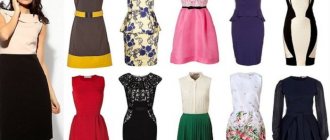If you are going to place an order in an online clothing store, you will not be able to try on the model you have chosen, since it is located at a great distance from you. Therefore, you need to know absolutely all your parameters in order to always be able to choose exactly the size that best suits you. When you know all your indicators, it will not be a problem to order clothes from other cities and even countries, because you will be able to choose the right size based on the data you have. In addition, this skill will definitely come in handy for those who love to sew. After all, in order to sew any item of clothing, you need to know how to take measurements from yourself or from the person for whom you plan to sew these clothes. Therefore, it is imperative to know how to measure your shoulders and other parts of the body.
Shoulder Width Measurement
The main measurement concerning this part of the body is width. If you don't know how to measure your shoulders and where to start, then you should first of all find out the width of your shoulders. This is the easiest part of measuring as you just need to place one end of the measuring tape to the edge of one shoulder and then measure to the edge of the other shoulder. This is called shoulder width. At the same time, you need to make sure that the person is not hunched over, slouched or does not spread his shoulders too wide - they must be in a natural state for the measurement to be as accurate as possible. By the way, knowing your shoulder width can help you not only in choosing clothes in an online store or when sewing your own, but also in sports, since the “feet shoulder-width apart” position is very often used there. And if you know how to measure your shoulders and what their width is, then it will be much easier for you to take this position.
We take measurements ourselves
- To create a pattern for a dress, skirt or trousers, measurements must be taken using the underwear. When trying on, wear the underwear with which you intend to wear the product. This is important because different bra shapes, for example, can change the height and girth of your bust.
- All measurements are taken on the most developed part of the body. For right-handers, measurements are taken on the right side, for left-handers - on the left.
- When taking measurements, you need to stand straight, without tension, in a position familiar to your body. It is quite difficult to take quality measurements of yourself. When the position of the body changes, its size also changes. A possible way out of the situation: take a product that fits you very well and take measurements from it.
- Mark the natural level of your waist with an elastic band or thin cord - this will simplify the task.
- Since the human body is symmetrical, the pattern is usually only drawn to the middle of the figure. For ease of use, some measurements are recorded in half size. These measurements include the semi-circumference of the neck, chest, waist and hips, back width, width and center of the chest. The remaining dimensions are recorded and used in full.
- Different countries have slightly different pattern making systems and measuring methods. And depending on the school, the names of the measurements may vary within one country. If you are not sure what size we are talking about, read the description. This way you can quickly find a match.
If a tailor sews clothes for himself, then he can take most of the measurements himself. But the question inevitably arises: how to measure shoulder width without outside help? To do this, you can take your own shirt or T-shirt that fits perfectly on your shoulders, then straighten it on the table and use a tape to measure the distance between the points where the sleeve joins the shoulder line. This way you can take the correct measurement.
Shoulder coverage
Another important parameter that you need to be able to measure is shoulder circumference. It is necessary to ensure that the sleeves are the right size and not too narrow or too wide. Therefore, everyone should pay special attention to this aspect when learning how to measure shoulders. The main point in this case is the correct choice of measurement location. In fact, upper arm reach is a misnomer because it measures the reach of the forearm, but the name doesn't really matter. But the only important thing is that this parameter must be measured in the widest part, that is, on the biceps. It is worth noting that the hand should be in a relaxed state, freely extended along the body. There is no need to strain your muscles during the measurement process, since in this situation the sleeve will be much wider.
It is also very important not to tighten the measuring tape on your bicep too much so that the skin underneath it contracts, otherwise the reading will be inaccurate and the sleeve will end up smaller than needed this time. To measure, place the end of the measuring tape at the selected point and wrap the tape around your forearm until you feel that you are starting to pull - then take the final measurement. For accuracy, this measurement can be performed several times.
How to measure shoulders for clothes on Aliexpress?
Marking the shoulder size is not so difficult, the main thing is to know how to do it correctly. First of all, you will need a pen, paper and a measuring tape.
For the most accurate shoulder measurement, stand straight. It is even better if the posture is relaxed and calm, so that the position of the body does not change due to tension.
It is important to say about clothes. You should not take measurements in tight and thick clothes with a lot of decor. It is better to take measurements in thin underwear or even without it. In this case, you will get the most reliable result.
Shoulder Width Measurement
To measure shoulder width, first find the widest points on your shoulders. The distance between them is the required width.
If you need shoulder length, then measurements are taken slightly differently. In this situation, measurements are taken from the junction of the shoulder and arm to the base of the neck. For the most accurate result, it is better to bend your arm slightly at the elbow. This indicator is very important if you decide to purchase a shirt or other long-sleeved clothing Aliexpress
If you don’t have the opportunity to ask someone to measure the length or width of your shoulders, then you can take an old T-shirt and measure it.
Shoulder length measurement
Another parameter that may be useful to you is the length of the shoulder. Given the fact that there is also a neck between one shoulder and the other, you will not be able to divide the width of the shoulders in half to get each indicator separately. Therefore, a separate measure was introduced - shoulder length. It is measured from the base of the neck to the end of the shoulder, and again it is best to take several measurements to ensure that you get a more accurate figure and do not make mistakes. In clothing, the shoulder length may differ from your anatomical parameters - it depends on how exactly you want to sew the item of clothing.
How to take your own measurements correctly?
Measurements are performed under certain conditions: you need to stand straight, without tension, maintaining your usual posture, with your arms down; foot position - heels together, toes turned out. To prevent excess clothing from distorting the readings, it is advisable to take measurements based on your underwear. Paired dimensional indicators are recommended to be determined on the right side.
The waist line is fixed with a thin braid, which is positioned strictly horizontally when sewing shoulder products, and since it will lie on the figure when sewing waist products. The position of the shoulder seam (the point at the base of the neck and the shoulder at the edge of the shoulder) is marked with chalk or a pencil, the center of the chest with a pin.
Basic measurements
Height (R)
Height is a vertical measurement, determined by measuring the body from the top of the head to the floor; There are several ways to obtain this measurement. You can use a strip of cardboard with precise centimeter divisions, which should be attached to the wall at the appropriate height. The client (without shoes) stands with her back to the scale; height is determined using a right triangle (one side of which is applied to the wall, and the other, perpendicular to it, touches the top of the client’s head). Note: The updo should be lightly pressed.
Chest circumference (Og)
The chest circumference is measured from behind the client. The measuring tape passes through the protruding points of the mammary glands, through the back corners of the armpits and through the protruding points of the shoulder blades. The measuring tape should not be positioned horizontally; it should be raised at the back. Close the measuring tape in the middle of your back and hold it with your thumb and forefinger. Double-check its location on the figure, because... Bust girth is the most important measurement from which other measurements are calculated.
Waist circumference (from)
The natural waistline is secured with hook-and-loop tape (or cord) and should be positioned strictly horizontally on the body. Note: the presence of any belt item (skirt or trousers) on the client is unacceptable, because this will distort the measurement value. The measurement is taken while in front of the client. The measuring tape closes at the front, it runs along the tape that fixes the waistline.
Hip circumference (About)
When taking this measurement, you should stand to the side of the client and take the measuring tape approximately in the middle of the expected girth in your right (or left) hand. The measuring tape is passed horizontally along the most prominent points of the buttocks (Fig. S), closed and held in front by the thumb and forefinger. You should make sure that the measuring tape actually runs horizontally along the most protruding points of the buttocks.
Sleeve length (Dr)
The client should bend her outstretched arm slightly. Measure the length of the arm from the shoulder point (i.e. the end point of the designed shoulder seam) along the outer surface of the shoulder and forearm to the wrist.
Auxiliary measurements
Back length (chipboard)
Once the Armhole Depth has been determined, you should continue to hold the measuring tape with your left hand at the 7th neck band so that it hangs along the spine. With the other hand, press it at the level of the waist line against the horizontally applied waist tape and take the Back Length measurement at the bottom edge of the waist tape. Since Back Length is one of the two important balance measurements, it must be measured very accurately.
Product length (Di)
The length of the product is measured from the 7th cervical vertebra to the selected length of the model, immediately after measuring the three length measurements described above.
Chest Height (Vg)
Chest height (Br) is taken from the 7th cervical vertebra - a measuring tape runs along the base of the neck along the back to the point of the base of the neck on the side (i.e. to the highest point of the shoulder seam projected), then lowers down to the protruding point of the mammary gland, which will be indicated more clearly if you press the measuring tape under your breasts.
Front Waist Length (Rtp)
The centimeter fly must continue to be held at the 7th cervical vertebra. Along the base of the neck from the back, it passes to the most protruding point of the chest in the same way as when measuring Br (dgs), from where the tape hangs vertically down. It is pressed with the hand against the waist band, which, as already mentioned, is located on the client's waist. At the bottom edge of the waist tape, determine the Front Waist Length, taking into account the Back Neck Length. Since Front Waist Length is the second important balance measurement, it must be taken as accurately and carefully as the Back Length measurement.
Back Width (Shs)
It is advisable to take Shs measurements from the client when she is wearing only underwear. But there is a technique that will help take measurements from the client if she is wearing any clothes. The volume of the item is evenly shifted forward so that the fabric on the back is stretched as tightly as possible. With pubescent arms, two pronounced folds form on the clothing, marking the boundary between the back and arms (i.e., the back corners of the armpits). The width of the back is measured between the posterior corners of the armpits, placing the measuring tape horizontally with some tension, along the most protruding points of the shoulder blades.
Shoulder circumference (Op)
This measurement is taken horizontally at the level of the posterior corners of the armpits. The measuring tape is applied as always when taking measurements - very tightly. In the drawing, the width of the sleeve should be several centimeters (increase in freedom of fit) larger than the shoulder circumference (Op) measurement, even for a narrow sleeve.
Wrist circumference (Ozap)
Wrist circumference is measured at the level of the wrist. When constructing the sleeve, an allowance is added to this measurement for the freedom of fit, even with a narrow sleeve.
Neck circumference (Osh)
The measuring tape should run along the base of the neck and close to the side.
Shoulder width (W)
Measure the width of the shoulder from the highest point of the designed shoulder seam (at the base of the neck) to the end point of the designed shoulder seam.
Separate parameter
These are the three main parameters that are the keys to how to measure your shoulders correctly. But there is an additional aspect that does not require a measuring tape, because it must be measured visually. This is the tilt of the shoulders. This parameter has only three values, but it can greatly affect the process of sewing clothes. In this case, it doesn't take a genius to figure out how to measure your shoulders and their slope. It is enough just to know that the standard degree at which they are located is somewhere between 20 and 25. Such numbers are considered normal, while a larger angle means sloping shoulders, and a smaller angle means square. This parameter should also be taken into account when choosing clothes remotely or when sewing them yourself.











